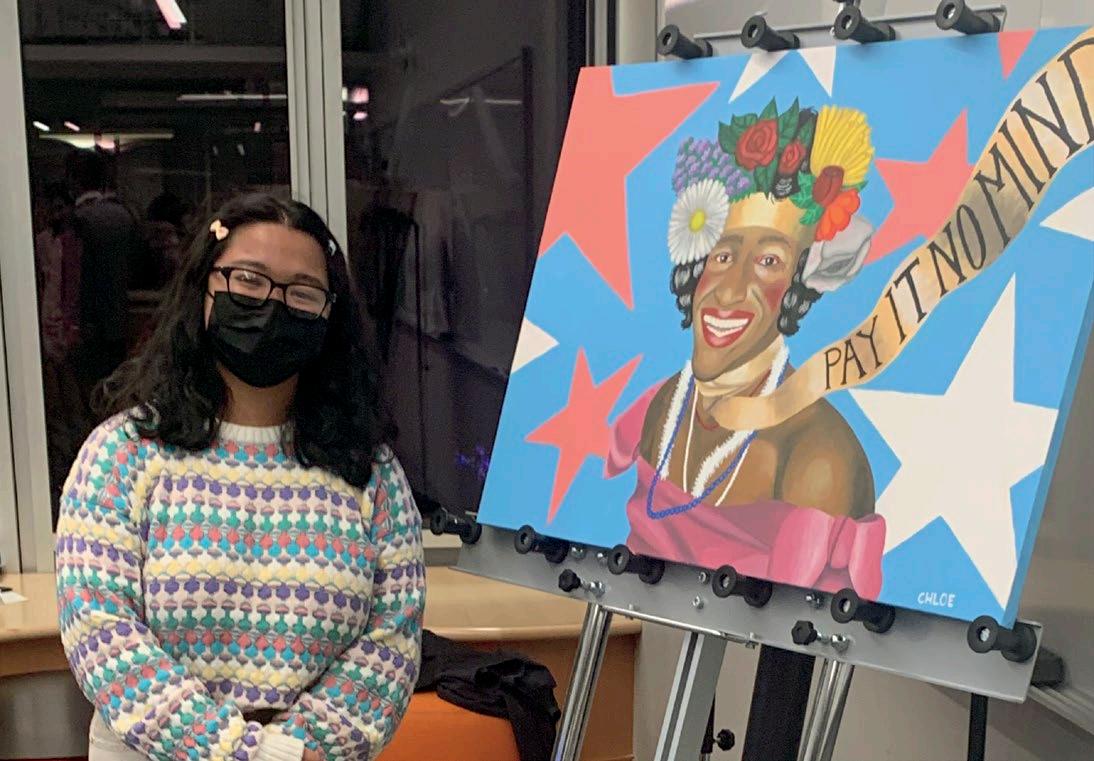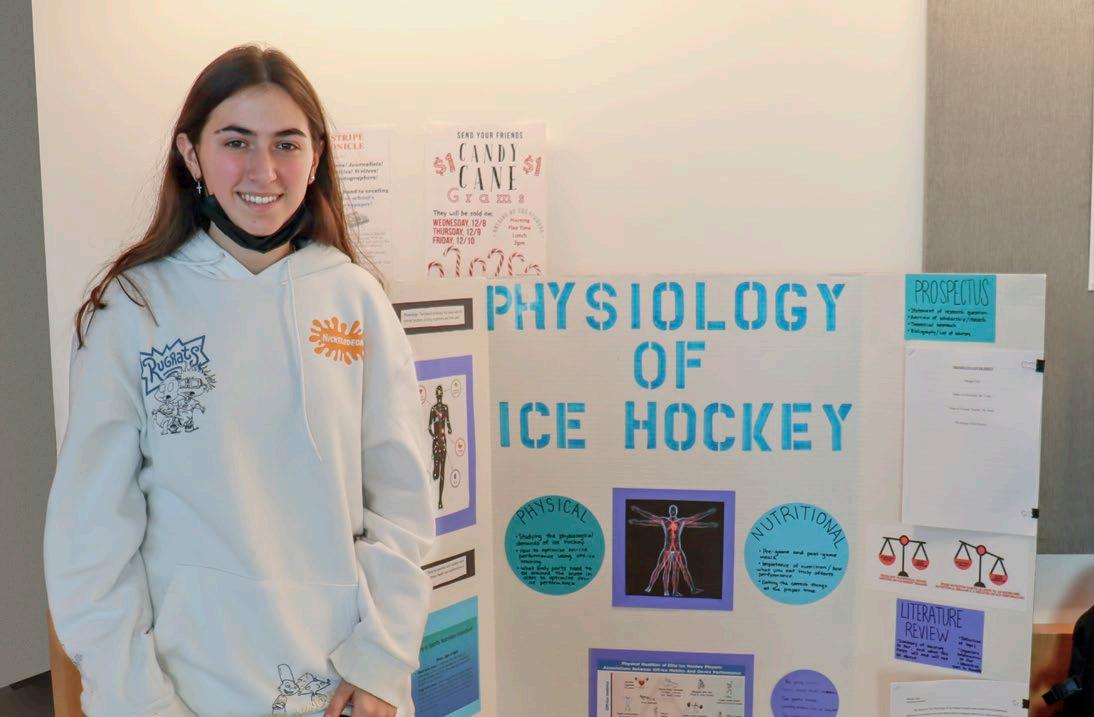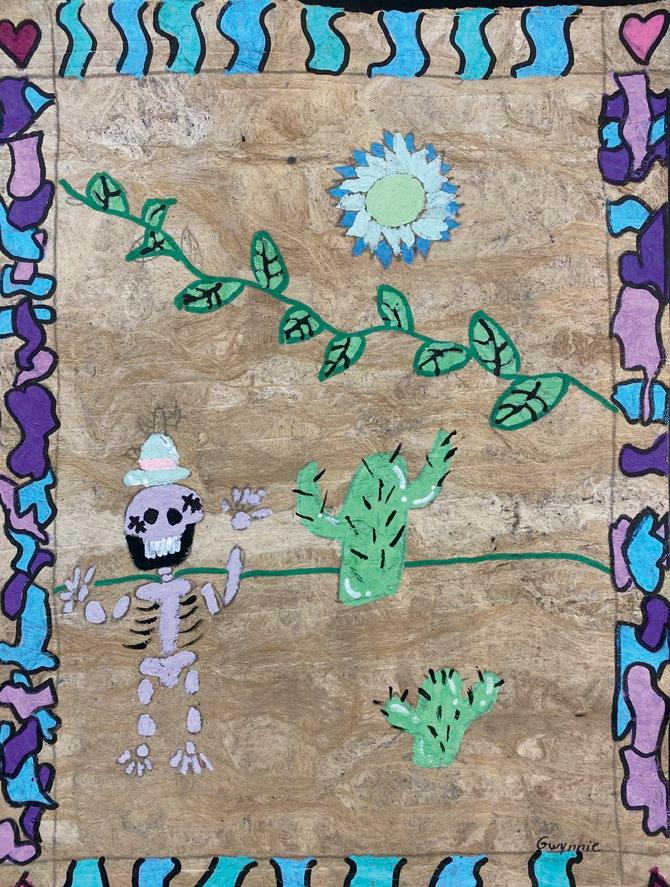
4 minute read
Exhibitions of Learning
Tenth Graders Investigate Systems of Power & Dissidents Who Change Them
Tenth graders turned the Upper School into an art gallery with multi-media representations of figures from American and international history who challenged their societies and structures of power: people like the late Chief Justice Ruth Bader Ginsburg; Ida B. Wells, a prominent journalist; Albert Einstein, the Nobel Prize-winning physicist; Banksy, a street artist; the second U.S. President John Adams; Henry David Thoreau, a philosopher and essayist; and Virginia Hall, an American spy during WWII. The theme of this year’s exhibition, which took place on Dec. 14, focused on the concept of dissidence and debate, and spanned tenth-grade History, English, Art, and Chemistry classes. Students examined the role of dissidence in the larger context of power and systems—a particular focus of their Seminar classes. Concurrent with this work, students researched and wrote about a dissident of their choice. They also developed artistic representations of this figure in one of a variety of ways including sculptures, original musical compositions, and copper etchings—all of which were presented at the exhibition.



Eleventh Graders Present Preliminary Research on Junior Thesis Topics



All GCDS eleventh graders complete a Junior Thesis on a topic of interest by the end of their junior year. On the evening of Dec. 13, the students presented their preliminary research on their topics, walking families and friends through their process and discussing their research directions going forward.
At the time of the exhibition, students had finished their prospectus and literature review, and were sharpening their investigative focus. Students shared how they chose their thesis topics, the sources they are using, where their research is taking them, and whether their topic has changed over time.

The goal of the night was to solicit feedback from community members, inviting parents, teachers, and friends into the interdisciplinary research process. Roving around the building, this diverse audience engaged our eleventh-grade researchers well into the evening, making connections, offering resources and ideas, and collaborating on solutions to research challenges.
“Our students are becoming experts in their chosen fields,” said Stephanie McDonald, Dean of Student Life and the Junior Thesis Advisor. “This was evident throughout the EOL.”
By the end of the school year, students will defend their thesis, (which has a substantial written component—an approximately 20-page paper), to a faculty committee, selected by the student and thesis advisor, for final assessment. On May 10, they will also exhibit their research findings to the community in Junior Thesis exhibition night. This evening will also showcase exhibitions of our students’ work in advanced visual and performing arts. Keep an eye out for the invitation!
Exhibitions of Learning
Student work was also showcased on Old Church Road. On the morning of Dec. 6, fourth graders treated their families to a “Celebración sobre México,” a celebration highlighting all that they had learned about the country. In addition, Grade 2 proudly displayed their intricate Lenape Village dioramas, which they created as they learned about the life and customs of the Lenape people, a Native American tribe.
Fourth Graders Celebrate Mexico across Disciplines

How does where you live impact how you live?” Using Mexico as a case study, fourth graders explored this essential question in all of their classes and through a variety of media. They researched Mexico’s history and culture, read “Dancing Home,” the story of cousins from two countries, explored the Mayan number system, and charted the migration of monarch butterflies in science class. They also created Papel Amate in art class, carved Folk Art Fish in woodshop, built bridges in the Maker Lab, learned classic songs from Mexico and sang them in Spanish, wrote dialogues about the weather in different regions of Mexico, and filmed short skits in Spanish. And, of course, no study of Mexico would be complete without a
“fútbol” tournament across the grade, class against class.
As part of the unit, Katarina Amen, a fourth grader, wrote a report about the holidays in Mexico focusing on Las Posadas, a weeklong celebration during Christmas. “I really liked that I could choose what I wanted to do my report about and that I did research. I also learned a lot from my friends’ reports.”
The fourth-grade study culminated in a Celebración sobre México, Dec. 6, where students presented their learning to their parents.
“The students took ownership of their work and were so proud as they demonstrated their learning to their parents,” said Maddie Roberts, a fourth-grade teacher. “Because they had an audience, they had a different sense of purpose. These fourth graders are getting prepared for their high school Exhibitions of Learning!”
Second Graders Re-create Lenape Villages as Dioramas
Second-grade students learned about the history and culture of the Lenape people, a community indigenous to the lands surrounding GCDS. The students’ culminating project—Lenape Village dioramas—provided an opportunity to showcase their learning. The displays depicted the daily activities of the community in the 1600s. Students learned about the homes they lived in, the food they ate, and the clothes they wore. In the Creativity Lab, students built wigwam structures and learned how to make a light circuit to create a glowing fire for the center of the wigwam.
“I liked making a canoe, the beehive, baskets, and people,” said Eloise Swanson, a second grader. “It was fun to learn how the Lenape made pottery and then try to make it yourself. We built what we learned about.”
Since each diorama was created by a group of students, the project required student collaboration and communication. “Students worked to solve problems together and creatively and respectfully share their understanding of Lenape culture and lifestyle as a team,” said Betsy Warren, a second-grade teacher. “Their curiosity and enthusiasm were palpable! As a teacher, it was a joy to watch them build something they were truly proud of.”
Second-grade families enjoyed seeing the finished products when they attended the Winter Concerts. )
















